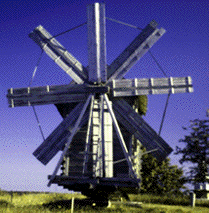 Ecological design
Ecological designNavigating the site:
Environmental criteria
How do you judge the sufficiency of a good ecological design (ED)?
1. You need to develop design and define ecological criteria:
2. Make a list of features that --based on the readings-- that are ecologically appropriate.
3. Relating sensory information to ecological functions.
4. Developing criteria, sources for:
A Russian windmill from the premodern era.
criteria - [Greek]; kriterion; a means of judging, from krites; to judge.
A standard measure, or accepted rule. The underlying assumption at play in any decision.
| singular | plural |
| Criterion | Criteria |
|
measure
|
measures
|
|
standard
|
standards
|
A standard, rule, or test by which something can be judged. A measure of value. The means used to create a standard.
"beyond a reasonable doubt"
In a jury trial, jury members in a capital case are expected to have no serious doubts about the guilt of the person charged, before passing judgment.
"sufficiency of the evidence"
In a jury trial, jury members in a civil proceeding or non-capital case (where a crime has not been committed that ended in death), jury members are expected to weigh the evidence and decide guilt or innocence by the preponderance of the material supporting the facts in the case.
"beauty is in the eye of the beholder"
That saying implies that individuals make up their own minds on the quality of people, places and objects, based on beliefs peculiar to each person's instructional and emotional backgrounds.
Since beauty means "pleasing" to the senses and each individual's senses are personal the standards may differ widely from person to person, across groups or among cultures to which different observers belong.
Relating aesthetic concepts to ecological conditions
Wildlife biologist Aldo Leopold, in A Sand County Almanac, wrote that, "The taste for country displays the same diversity in aesthetic competence among individuals as the taste for opera, or oils [art]."
"A Taste for Country," implies that everyone may judge natural landscape features differently, but that poor judgment can be related to inexperience, lack of exposure to countryside, and and inability to see details.
"In country, as in people, a plain exterior often conceals hidden riches, to perceive which requires much living in and with."
This idea that there is more than meets the eye is a judgment based on criteria. Leopold's criteria is an expression of an aesthetic sensitivity to those crucial features that form productive landscapes.
Consider Leopold's implicit (inherent or implied by but not overtly drawn out in what is stated) argument about landscape.
When in developing criteria for plans consult:
Ian McHarg: Design with Nature, (1968).
Sim Van der Ryn, Ecological Design, (1998).
Siry, Marshes of the Ocean Shore, (1984).
Siry, "Gardens" and Florida Trees, (2000).
Forests' role in sustaining civilizations.
Bill McKibben, Death of Nature, (1991-2000).
Garrett Hardin, Living Within Limits, (1995).
Mary Austen, Land of Little Rain, (1900).
Arnold Pacey, Impacts of technology on landscape, (2003).


